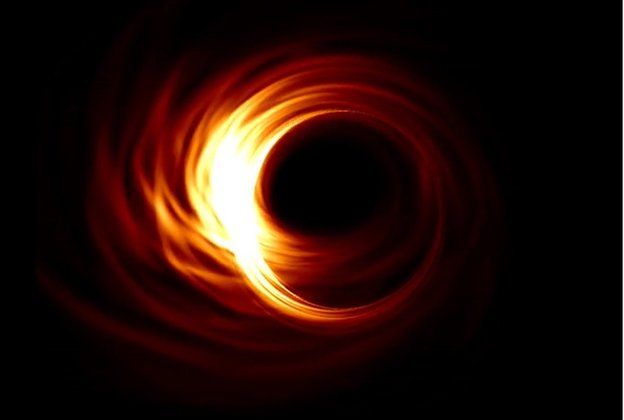Event Horizon Telescope ready to image black hole
- Published

Scientists believe they are on the verge of obtaining the first ever picture of a black hole.
They have built an Earth-sized "virtual telescope" by linking a large array of radio receivers - from the South Pole, to Hawaii, to the Americas and Europe.
There is optimism that observations to be conducted during 5-14 April could finally deliver the long-sought prize.
In the sights of the so-called "Event Horizon Telescope" will be the monster black hole at the centre of our galaxy.
Although never seen directly, this object, catalogued as Sagittarius A*, has been determined to exist from the way it influences the orbits of nearby stars.
These race around a point in space at many thousands of km per second, suggesting the hole likely has a mass of about four million times that of the Sun.
But as colossal as that sounds, the "edge" of the black hole - the horizon inside which an immense gravity field traps all light - may be no more than 20 million km or so across.
And at a distance of 26,000 light-years from Earth, this makes Sagittarius A* a tiny pinprick on the sky.
The Event Horizon Telescope (EHT) team is nonetheless bullish.
"There's great excitement," said project leader Sheperd Doeleman from the Harvard-Smithsonian Center for Astrophysics in Cambridge, Massachusetts.
"We've been fashioning our virtual telescope for almost two decades now, and in April we're going to make the observations that we think have the first real chance of bringing a black hole's event horizon into focus," he told BBC News.
The EHT's trick is a technique called very long baseline array interferometry (VLBI).
This combines a network of widely spaced radio antennas to mimic a telescope aperture that can produce the resolution necessary to perceive a pinprick on the sky.
The EHT is aiming initially to get down to 50 microarcseconds. Team-members talk in analogies, describing the sharpness of vision as being the equivalent of seeing something the size of a grapefruit on the surface of the Moon.
They emphasise the still complex years of work ahead, but also trail the prospect of an imminent breakthrough.
Sheperd Doeleman: "It's never a good idea to bet against Einstein"
The scientists certainly have an expectation of what they ought to see, if successful.
Simulations rooted in Einstein's equations predict a bright ring of light fringing a dark feature.
The light would be the emission coming from gas and dust accelerated to high speed and torn apart just before disappearing into the hole.
The dark feature would be the shadow the hole casts on this maelstrom.
"Now, it could be that we will see something different," Doeleman said.
"As I've said before, it's never a good idea to bet against Einstein, but if we did see something that was very different from what we expect we would have to reassess the theory of gravity.
"I don't expect that is going to happen, but anything could happen and that's the beauty of it."
Katie Bouman: "If we could make movies it might help us pull out extra information"
Over the years, more and more radio astronomy facilities have joined the project. A key recent addition is the Atacama Large Millimeter/submillimeter Array (ALMA) in Chile.
Its extraordinary state-of-the-art technology has at a stroke increased the EHT's sensitivity by a factor of 10. Hence, the optimism ahead of April.
Even so, scientists have had to install special equipment at all the radio facilities involved in the observations.
This includes big hard drives to store colossal volumes of data, and atomic clocks to precisely timestamp it all.
Nothing happens on the spot - the hard drives must first be flown to a large computing facility at MIT Haystack Observatory in Westford, just outside Boston, Massachusetts.
"Our hard-drive modules hold the capacity of about 100 standard laptops," said Haystack's Vincent Fish.
"We have multiple modules at each telescope and we have numerous telescopes in the array. So, ultimately, we're talking about 10,000 laptops of data."
It is in Haystack's correlator computer that the synthesis will begin.
Some very smart imaging algorithms have had to be developed to make sense of the EHT's observations, but it will not be a quick result.
It could be the end of the year, perhaps the start of 2018, before the team releases an image in public.
Looking to the future, the scientists are already thinking about how to extend their techniques.
For example, the matter closest to the event horizon and about to disappear into Sagittarius A* should take about 30 minutes to complete an orbit.
Katie Bouman, from MIT's Computer Science and Artificial Intelligence Laboratory, thinks it might be possible to capture this movement.
"We want to push boundaries and to try to make movies from the data," she told BBC News.
"Maybe we can actually see some of the gas flowing around the black hole. That's really the next stage of what we're trying to accomplish with these imaging algorithms."
First and foremost, the team needs good weather at the participating observing stations in April.
The strategy is to view the galactic centre at a wavelength of 1.3mm (230GHz). This has the best chance of piercing any obscuring gas and dust in the vicinity of the black hole. But if there is too much water vapour above the array's receivers, the EHT will struggle even to see through Earth's atmosphere.
Just getting a resolved view of Sagittarius A* would be a remarkable triumph in itself. But the real objective here is to use the imaging capability to go test aspects of general relativity.
If there are flaws to be found in Einstein's ideas - and scientists suspect there are more complete explanations of gravity out there waiting to be discovered - then it is in the extreme environment of black holes that limitations should be exposed.
Jonathan.Amos-INTERNET@bbc.co.uk and follow me on Twitter: @BBCAmos